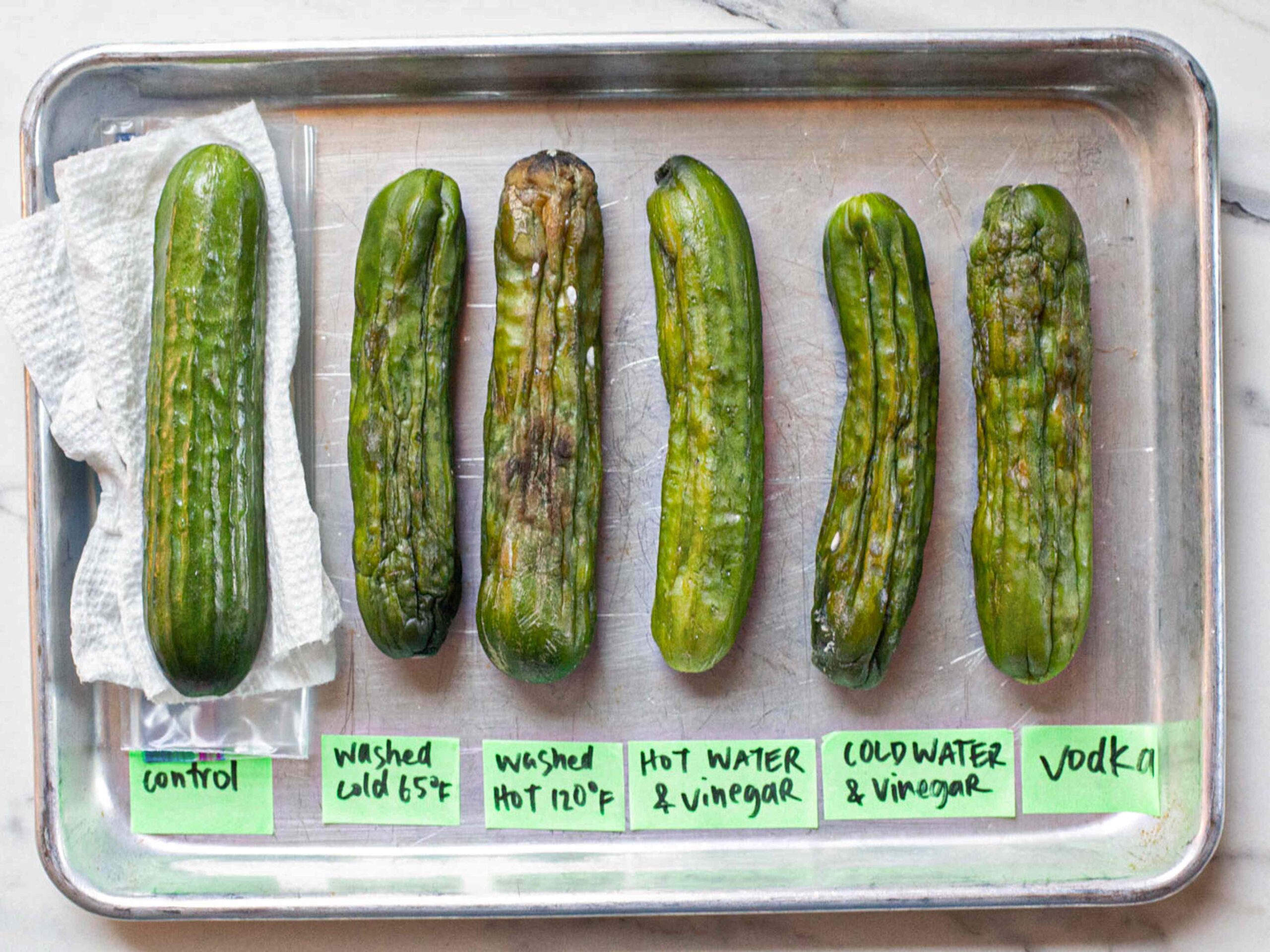:max_bytes(150000):strip_icc():format(jpeg)/20250728-SEA-HowToStoreCucumbers-IrvinLin-01-1c3d51a402b241c89e678f586495f529.jpg)
Though cucumbers are best eaten within two to three days, most unwashed cucumbers can stay fresh for up to seven days when stored in a humid environment in the refrigerator, such as a crisper drawer, resealable zip-top bag, or left in their original plastic wrap.
In the summertime, I love tossing cucumbers into a salad, pairing them with dips, or using them to make a refreshing appetizer. As delicious as cucumbers are, keeping them fresh can be a challenge: They often go from firm and crisp to soft and slimy, due to poor storage conditions and naturally occurring bacteria or mold spores in their environment. To combat this, some home cooks and chefs swear by specific washing or storage methods.
Becky Seleutchef and cookbook author of Misunderstood Vegetables, tells me she believes that the English cucumbers sold tightly wrapped in plastic last the longest, especially if you pick one with very firm ends. When she has to store unwrapped cucumbers, however, she keeps them in a cloth or plastic bag that isn’t fully sealed to prevent moisture from accumulating. In a conversation with Ariela Gottschalk, owner of Halcyon FarmsGottschalk shares that she stores her Persian cucumbers unwashed at room temperature on the kitchen counter, where her 13-year-old scarfs them down before they have a chance to spoil.
With cucumber season in full swing, I decided to test various methods to find which are best for keeping cukes fresh for as long as possible.
Cucumber Basics
There are numerous cucumber varieties, but only a few are easily found at the grocery store or farmers markets. Cucumbers, which are botanically a fruit, belong to the Cucurbitaceae (gourd) family that also includes sweet melons and squashes. Like their relatives, they are most often used in savory dishes.
Harold McGee notes in On Food and Cooking that cucumbers were originally domesticated in India around 1500 BCE, and quickly spread across the globe. The Roman emperor Tiberius reportedly adored cucumbers, and Charlemagne, king of the Franks, also grew the gourd in his Italian gardens. Christopher Columbus supposedly introduced cucumbers to Haiti in 1494; from there, they made their way to the Americas.
Cucumbers have a wide range of colors, textures, and flavors. Some of the most popular varieties in the US today include: the standard American slicing cucumber, which has relatively big seeds and a thick skin; the small, thin-skinned Persian cucumber; the long, skinny English cucumber (which is often sold individually plastic-wrapped); and the short, stubby Kirby cucumber, commonly used for pickling. Farmers market shoppers may encounter heirloom varieties, such as the round lemon cucumber, oval Boothby’s Blonde cucumber, the pale yellow White Wonder, and the Japanese Climbing Cucumber, among many more.
Because cucumbers vary widely in shape, size, and skin type, it’s hard to give one-size-fits-all storage advice. To find the best approach for the most common cucumber varieties in US markets, we tested how washing, refrigeration, and humidity affect their shelf life.
Serious Eats / Nader Mehravari
How to Store Cucumbers, According to the Experts
According to the Department of Plant Sciences at the University of California, Davis, the best temperature for storing cucumbers post-harvest is somewhere between 50 and 55°F (10 to 13°C), which is quite a bit colder than room temperature but warmer than most refrigerators. Colder temperatures can lead to chilling injuries—such as yellowing, softening, or black mold spots—after just two to three days.
UC Davis also recommends storing cucumbers at about 95% relative humidity to help prevent moisture loss and shriveling. Cucumbers are sensitive to ethylene, a gas produced by some fruits and vegetables as they ripen. For this reason, UC Davis advises storing cucumbers away from high-ethylene-producing fruits, such as bananas, melons, and tomatoes.
How to Shop for Cucumbers
To maximize shelf life, Cara Mangini, author of The Vegetable Butcher, recommends choosing cucumbers that are bright green and evenly colored. Avoid any that are yellow or brown, unless you’re selecting an heirloom variety with naturally yellow or brown skin. In her book, Mangini also advises selecting cucumbers that are firm, especially at the tips, which tend to soften first. Be sure to avoid cucumbers that are soft or wrinkled.
The Tests
I wanted to test various factors for storing cucumbers: washed vs. unwashed, refrigeration vs. room temperature, and humid environments vs. those with good airflow. I used three common grocery store varieties: small, thin-skinned Persian cucumbers; thick-skinned American slicing cucumbers; and long, thin-skinned English cucumbers, which are typically sold shrink-wrapped.
Test One: Does Washing Cucumbers Make a Difference?
I began by testing different washing methods, using only Persian cucumbers to keep the results consistent. All samples were stored on my kitchen counter at room temperature, about 65°F (18°C).
Here are the variables I tested:
- Cucumber unwashed, wrapped in a clean paper towel and stored in a sealed reusable zip-top bag
- Cucumber washed in 60°F (15°C) water
- Cucumber washed in 120°F (49°C) water
- Cucumber washed in a solution of four parts 60°F (15°C) water and one part white distilled vinegar
- Cucumber washed in a solution of four parts 120°F (49°C) water and one part white distilled vinegar
- Cucumber washed in vodka
Some produce, such as strawberries, last longer when washed, while others, such as cherries, do not. For my first test, I wrapped a single Persian cucumber in a dry paper towel and sealed it in a zip-top bag as my control. I then washed the remaining cucumbers using the methods above. I stored them all on the counter at room temperature.
The unwashed cucumber wrapped in a paper towel and placed in a zip-top bag stayed fresh the longest. After seven days, all of the washed cucumbers had begun to brown, wrinkle, or show signs of mold. Though the paper towel wrapped around the cucumber was damp, the unwashed cucumber still felt firm and looked edible.
The vodka-washed and vinegar solution cucumbers came in a distant second and third, respectively. Even though they didn’t fare as well as the control, I decided to advance those two methods to the next round of testing with additional cucumber types.
Test Two: Washing, Extended to Two Other Common Cucumber Varieties
Once I identified the most effective and promising washing methods for Persian cucumbers, I applied them to two additional types: a waxed American slicing cucumber and an unwaxed, plastic-wrapped English cucumber. I left all the cucumbers at room temperature (65°F/18°C).
The methods I tested included:
Waxed American Slicing Cucumbers
- Unwashed
- Unwashed, wrapped in clean paper towels, and stored in a zip-top bag
- Washed in a solution of four parts 120°F (49°C) water to 1 part vinegar
- Washed in vodka
Unwaxed English Cucumbers
- Unwaxed, plastic-wrapped English cucumber
- Unwaxed English cucumber with plastic removed, unwashed, wrapped in paper towel, and placed in a zip-top bag
- Unwaxed English cucumber with plastic removed, washed in four parts water (120°F/49°C) to 1 part vinegar
- Unwaxed English cucumber washed in vodka
For the American slicing cucumber, the winner was the unwashed cuke wrapped in a paper towel and stored in a zip-top bag. After four days, all the other samples had begun to wrinkle, while the bagged one remained plump and firm, though a small amount of mold had started to form at one end.
For the English cucumber, the one left in its original plastic wrap came out on top. After four days, those that had been unwrapped and/or washed began to shrivel, soften, or yellow, while the wrapped one remained firm and bright green.
Test Three: Does Refrigeration Matter?
After determining that unwashed cucumbers held up best, I decided to test whether refrigeration made a difference. These are the tests I ran:
- Unwaxed English cucumber, left in its original plastic wrap and stored in the crisper drawer
- Unwashed waxed American and unwaxed English cucumbers, stored loose in the crisper drawer
- Unwashed waxed American and unwaxed English cucumbers, wrapped in paper towels, placed in zip-top bags, and stored in a crisper drawer
In every case, the refrigerated cucumbers stayed fresh longer than those stored at room temperature. Cucumbers stored at room temperature began to wrinkle, lose moisture, or mold within three days. The waxed American cucumber wrapped in a paper towel and stored in a zip-top bag remained fresh for five days, while the plastic-wrapped English cucumber lasted seven days with no visible signs of spoilage.
Serious Eats / Irvin Lin
Key Takeaways and Conclusion
The winners were the unwashed cucumbers stored in the refrigerator, either in a crisper drawer or sealed in a zip-top bag. Kyle Hagerty of Urban Farmstead tells me, “Cucumbers are mostly water, so they get soft as they dry out. The thicker [a cucumber’s] skin, the more slowly it dries out. Persian cucumbers and any of the smaller cocktail cucumbers have the thinnest skin and a shorter shelf life. Pickling cucumbers have very thick skin, which helps them maintain a firm texture when pickled.”
Cucumbers begin decomposing as soon as they’re harvested, and most American commercial cucumber producers coat their cukes in wax to prevent them from drying out. As cucumbers soften and lose moisture, they lose their signature crunch. Storing cucumbers in a humid environment helps prevent this: The more moisture in the air, the harder it is for the water inside cucumbers to escape. Both the wax coating and plastic wrap act as barriers that reduce moisture loss, which likely explains why unwashed and still-packaged cucumbers outlasted those that were washed or unwrapped.
Simon Richard, the producer manager at California’s Bi-Rite Markets agrees: “I wouldn’t wash any of the cukes before storing. Regular table cucumbers [such as American slicing cucumbers] have a thick skin and will store longer in a fridge, whether they’re in a compostable produce bag or a plastic bag. The Japanese, Persian, and English cucumbers have much thinner skin. That’s why you’ll see English wrapped in plastic and Persian in plastic containers.” It’s possible that washing waxed cucumbers may remove some of that protective coating, making the fruit more susceptible to spoilage.
If you plan to eat your cucumbers within two to three days, it doesn’t matter much how you store them—they’ll last that long unwashed on the counter. However, if you don’t plan on using them immediately, it’s best to keep them unwashed and refrigerated in a humid environment, either in the crisper drawer or a resealable zip-top bag. If your cucumber comes wrapped in plastic wrap or a container, leave it that way. Cool and humid is your goal. When properly stored, cucumbers can last five to seven days, or even longer, depending on the variety.
Quick Tips for Cucumber Shopping and Storage
- Buy firm, bright, and evenly colored cucumbers, free of blemishes and wrinkles. Pay particular attention to the ends of the cucumber for firmness, as that’s where they soften first.
- If your cucumber comes wrapped in plastic or comes in a plastic container, leave them in there. If not, place them in a produce bag or Ziploc bag (unsealed)
- Place the cucumber in a crisper drawer if you don’t want to use a bag.
- Refrigerate immediately.

